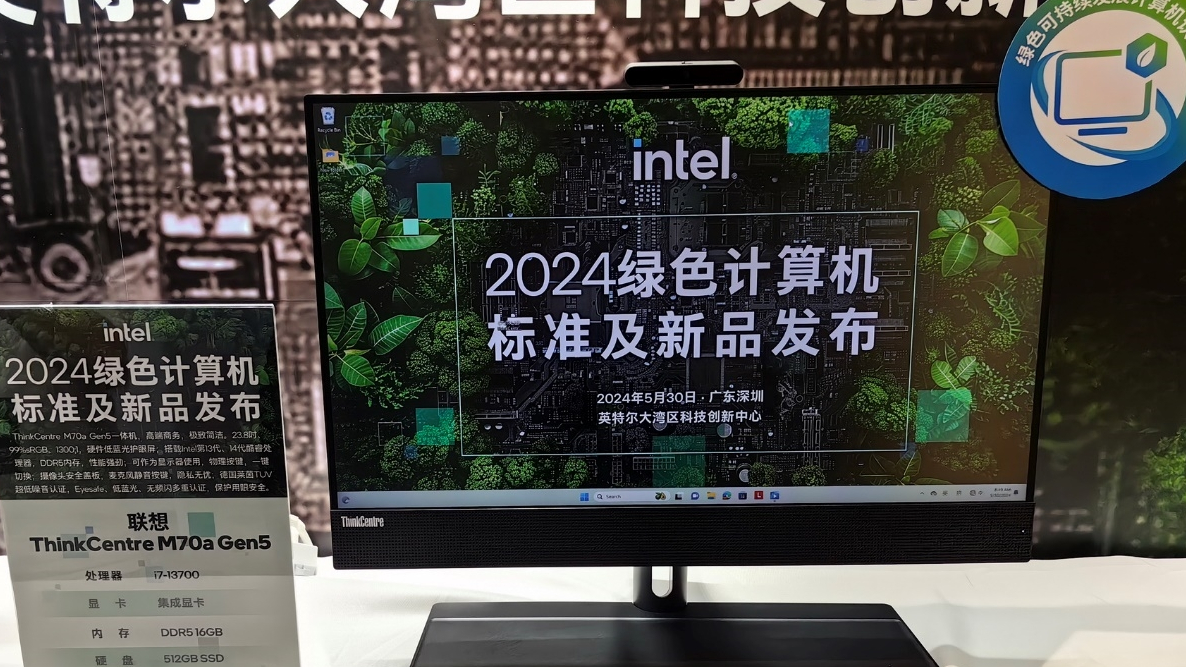Intel launches Green PC grading standard in China — partner OEMs prepare Bronze, Silver, and Gold-rated systems
China OEM partners include Asus, Dell, HP, Lenovo, and lesser-known local brands.

Following the February unveiling of a 90% recyclable Green PC concept by Intel and partners in Beijing, major manufacturers have banded together in China to release a set of Green PC grading and implementation standards. Five evaluation units are included in the standard, with 15 first-level and 27 second-level indicators per standard unit.
The five evaluation units required for receiving a Green PC grade are apparently "Design Definition," "Production Delivery," "Use & Maintenance," "Recyclability," and an unnamed bonus item. Final scores with less than 60 points will receive no Green PC grading, while 61-74 points receive Green PC Bronze grading, 75-89 points receive Green PC Silver grading, and 90+ points of course receive Green PC Gold grading. This grading system is expected to be used in future PC labels, at least in China, though we wouldn't be surprised to see the same or a similar system come Stateside.
Besides refining their grading system, Intel unveiled some actual upcoming Green PCs alongside the likes of Asus, Dell, HP, Lenovo, H3C, Panlong, and Tongfang.
Green PCs Shown at Intel's May 2024 Green PC Press Conference
- Tongfang Chaoyue A7000 — An all-in-one design that leverages mobile hardware (most likely upcoming mobile Intel Core Ultra CPUs, prior gen used Gen 12) to ease the green requirements.
- Panlong Tenglong — A thin desktop leveraging a 15th Gen Core i5 and 16GB RAM.
- H3C H3C Desk X500s G2 — A thin, short desktop design with up to 14th Gen Intel Core i9-14900, up to 64 GB of RAM, and (apparently) eGPU support.
- Asus D700MER — A pretty standard desktop design with a 14th Gen Intel Core i5-14400 and up to 128 GB RAM.
- Dell OptiPlex 7020 — A standard desktop design with a 14th Intel Core i5-14500, and up to 64 GB RAM.
- HP Pro SFF 280 G9 — A thin, tall desktop design with 12th Gen Intel Core i5-12400 onboard and only an 8GB RAM configuration offered out-of-box.
- Lenovo ThinkCentre M70a Gen5 — A short desktop design with a 13th Gen Intel Core i7-13700, but only 16GB of RAM.
Overall, the new grading system does seem to be promising, though how successful this lineup of Green PCs will actually end up being remains to be seen. We'll also most likely be waiting a long time, if ever, to see this new green PC grading standard make its way to the United States and become more immediately relevant to Western consumers. Not that everything needs to be tailored for the West — just that the Green PC grading seems like something we could use, too.
Get Tom's Hardware's best news and in-depth reviews, straight to your inbox.

Christopher Harper has been a successful freelance tech writer specializing in PC hardware and gaming since 2015, and ghostwrote for various B2B clients in High School before that. Outside of work, Christopher is best known to friends and rivals as an active competitive player in various eSports (particularly fighting games and arena shooters) and a purveyor of music ranging from Jimi Hendrix to Killer Mike to the Sonic Adventure 2 soundtrack.
-
_Shatta_AD_ LOL!!! Tech companies will find all sorts of excuses to market their shortcomings as a feature. Cannot sell powerful motherboards, servers, CPUs and GPUs? No problem! Underclock, handicapped, nurfed and reduced quality components then market them as the shiny “new”, “cutting edge”, “environment saving”, GREEN standards!Reply
While we’re at it, let’s further cut our lowest tier entry products into Olympic schemes and jack up the price more than the US performance tiers cause it’s the futuristic Gold rated GREEN PC!! -
bit_user For the US market, it would make more sense simply to update the Energy Star ratings:Reply
https://en.wikipedia.org/wiki/Energy_Star#Computers -
CmdrShepard Reply
I doubt this "green" has anything to do with energy, more like Intel being green with envy that ARM is slowly starting to eat their lunch.bit_user said:For the US market, it would make more sense simply to update the Energy Star ratings:
https://en.wikipedia.org/wiki/Energy_Star#Computers -
bit_user Reply
Yes, I also had the thought to "read between the lines". If Intel is emphasizing efficiency, it must be in response to some perceived threat.CmdrShepard said:I doubt this "green" has anything to do with energy, more like Intel being green with envy that ARM is slowly starting to eat their lunch. -
wr3zzz Replybit_user said:For the US market, it would make more sense simply to update the Energy Star ratings:
https://en.wikipedia.org/wiki/Energy_Star#Computers
Energy Star is about electricity usage and Green PC is about cutting down e-waste. We can, and should, have both. I don't get why are people against this. -
slightnitpick Reply
All else held equal you are absolutely right. But these companies survive through engineered obsolescence. Without longer computer lifespans and easy part-by-part upgrades (as opposed to having to buy multiple parts just to upgrade one part) this sort of thing comes off as greenwashing.wr3zzz said:Energy Star is about electricity usage and Green PC is about cutting down e-waste. We can, and should, have both. I don't get why are people against this.
Of the criteria, only "Use and Maintenance", and possibly "Design Definition" or the unnamed fifth "bonus" criteria, seem like they hit these marks. Making recyclability easier is great for end of life, but extending the time to end of life is better.
